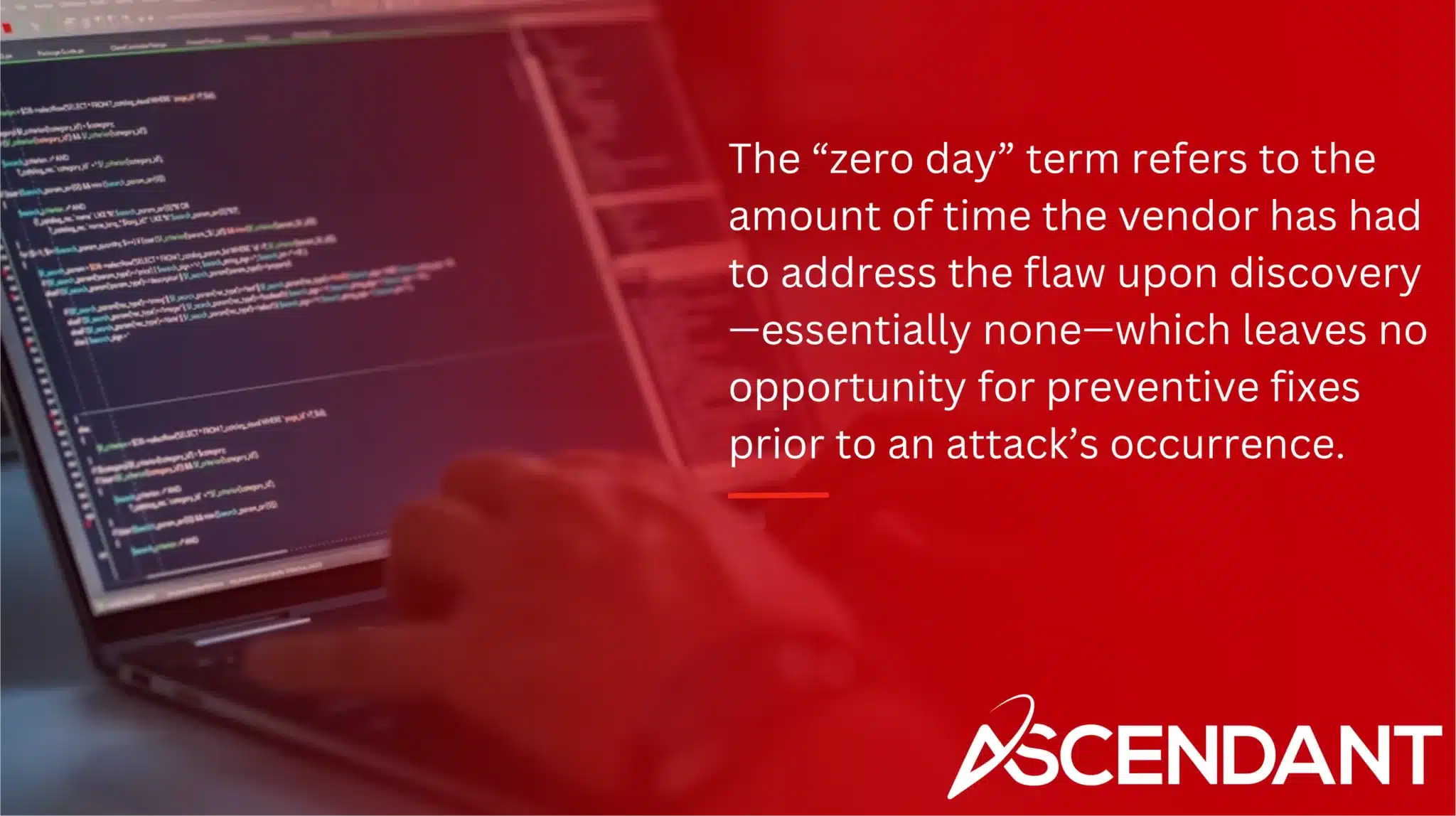A zero day attack targets unknown software vulnerabilities, leaving systems open to exploitation without immediate fixes. These attacks are especially dangerous due to the lack of available patches. This article will explain what zero day attacks are, why they are so effective, and how to protect your systems.
Key Takeaways
- Zero-day attacks exploit previously unknown software vulnerabilities, posing significant threats before patches can be released.
- Identifying and preventing zero-day vulnerabilities involves complex techniques, including vulnerability scanning, input validation, and proactive monitoring.
- A multi-faceted approach to security, including prompt patch deployment, next-generation firewalls, and automatic updates, is essential in mitigating the risks of zero-day attacks.
What is a Zero Day Attack?
A zero-day attack exploits an unknown vulnerability within software, representing a substantial security threat. These attacks are particularly perilous because they leverage security loopholes that have not yet been addressed with patches, thus leaving systems vulnerable. Before the developers even become aware of these issues, hackers find such vulnerabilities and exploit them to their advantage.

The “zero day” term refers to the amount of time the vendor has had to address the flaw upon discovery—essentially none—which leaves no opportunity for preventive fixes prior to an attack’s occurrence. This immediacy makes zero-day threats formidable and difficult to protect against effectively. Frequent types include lack of data encryption, susceptibility to SQL injections, or buffer overflows as instances of such software flaws.
Companies bear considerable responsibility in defending against zero day attacks by complying with regulations and ensuring sensitive information is well protected amidst today’s digital threat environment. Software vendors typically do not disclose discovered vulnerabilities until a patch can be developed. This creates a critical period where organizations remain at risk despite efforts being made.
Understanding how zero-day breaches occur is pivotal for effective defense strategies—acknowledging common system weaknesses along with familiar hacker tactics allows entities better fortify their cyber defenses against potential incursions.
High-Profile Examples of Zero Day Attacks
Instances of zero-day attacks that have garnered significant attention serve to underline the substantial threat these incidents pose. The assault known as Operation Aurora, launched in 2009, aimed at pilfering intellectual property from a number of leading firms, is one such instance. Sony Pictures suffered considerable harm during another prominent event in 2014 when attackers leveraged a zero-day exploit and unleashed confidential company data on the internet. This occurred due to exploiting an unknown security loophole within Sony’s infrastructure.
In yet another disturbing episode back in 2011, RSA fell victim to unauthorized access caused by an unaddressed vulnerability in Adobe Flash software, which led to critical loss of information and elevated their risk profile concerning security breaches. These occurrences highlight how crucial it is for organizations to adopt measures preemptively addressing potential threats posed by zero-day exploits before they can be exploited by malicious entities.
Identifying Zero Day Vulnerabilities
The detection of zero-day vulnerabilities, which represent a significant and intricate challenge in cybersecurity, is crucial. These security vulnerabilities can compromise diverse systems, including operating systems, web browsers, and IoT devices, by exploiting undisclosed or unpatched weaknesses. As no existing patches or antivirus solutions are available for these threats at the time they surface, identifying them poses considerable difficulty. To uncover new vulnerabilities and simulate potential attacks on software, security experts employ techniques such as vulnerability scanning.
It’s essential to adopt proactive defense strategies that encompass continuous monitoring and threat intelligence gathering to spot zero-day threats before adversaries take advantage of them. Maintaining vigilance and applying sophisticated methods for detection substantially improve safeguards against the risks posed by zero-day attacks.
Vulnerability Scanning Solutions
Scanning for vulnerabilities plays a crucial role in detecting zero-day vulnerabilities. It can reveal certain zero-day exploits, yet it doesn’t provide a full-proof safeguard for systems at risk. For thorough protection, organizations are expected to take prompt action on the outcomes of these scans, conduct reviews of their code thoroughly and cleanse their codebase to diminish the risks effectively.
Relying solely on vulnerability scanning falls short of offering complete security. There’s often a delay in organizational responses when new vulnerabilities emerge, resulting in opportunities for exploitation. To maintain an edge over evolving threats, entities must employ a strategic blend of vigilant scanning practices coupled with preemptive defense mechanisms.
Input Validation Techniques
Validating input is an essential defense against the exploitation of zero-day vulnerabilities. By verifying that data is properly formatted before processing, this technique minimizes the risk of malicious inputs taking advantage of undiscovered security flaws. It enables organizations to respond to emerging threats instantly and maintain their defenses even while patches are being developed.
Web application firewalls (WAF) serve as a critical component in validating input by scrutinizing and authenticating incoming traffic, thereby halting attacks at the network edge. For example, Imperva’s cloud-based WAF utilizes community-driven security intelligence to gather information on attack patterns and rapidly implement countermeasures against novel zero-day threats.
Strategies to Prevent Zero Day Attacks
A comprehensive strategy is necessary to thwart zero-day attacks. Given that these threats often render conventional tools such as antivirus programs inadequate, it’s vital to employ preventive security measures. Sophisticated defense mechanisms like runtime application self-protection (RASP) are pivotal because they safeguard applications instantaneously from day attacks by operating without relying on known threat signatures or immediate software patches.
It’s imperative for entities to adopt stringent patch management practices and expedite the implementation of software patches in order to minimize exposure to zero-day risks. Incorporating methods such as allowlisting and ringfencing can significantly diminish the hazards presented by vulnerabilities associated with zero days, enhancing overall security against such unpredictable assaults.
Implementing Security Patches
Swiftly applying security patches greatly reduces the risk of zero-day vulnerabilities being taken advantage of. It’s crucial to ensure that all software, from the operating system to various applications, is consistently updated to lessen these security risks.
Efficient patch management shrinks the potential target area for attacks by addressing known weaknesses, thereby diminishing chances for zero-day exploits. Utilizing automated systems for managing patches can also accelerate vulnerability resolution and cut down on the duration of susceptibility.
Using Next-Generation Firewalls
Advanced next-generation firewalls are equipped with capabilities such as application awareness and intrusion prevention, which bolster their effectiveness in detecting and thwarting zero-day threats. These systems employ deep packet inspection to discern and obstruct malevolent traffic aimed at exploiting vulnerabilities.
Next-generation firewalls are essential for adapting to emerging threats by serving a pivotal function in preventing the infiltration of zero-day malware, thereby safeguarding against new threats.
Enabling Automatic Updates
Consistently activating automatic updates guarantees that systems are regularly fortified with the latest security protections and corrections. Adopting this measure assures that users have up-to-date security patches, thereby diminishing their susceptibility to cyber attacks.
Such measures are crucial for programs like Adobe Flash Player and Internet Explorer as they frequently fall prey to zero-day exploits. By enabling automatic updates, users can ensure they swiftly acquire the most recent advancements in security.
The Role of Security Researchers and Zero Day Initiatives
Vulnerability researchers are essential in detecting and responsibly reporting zero-day vulnerabilities. The Zero Day Initiative (ZDI) incentivizes the confidential submission of such security flaws to vendors by providing financial compensation to those who discover them, fostering a collective of vulnerability experts focused on improving research and ethical disclosure practices.
As the most substantial vendor-neutral bug bounty program, ZDI maintains the secrecy of technical vulnerability details until an update or fix is released. By submitting their findings through ZDI, security researchers can track progress on how their disclosed zero-day issues are handled without directly interacting with vendors themselves. This cooperative approach promotes swift and efficient remediation of reported security gaps.
Staying Informed About Emerging Threats
Maintaining a solid security posture necessitates keeping abreast of emerging threats, including zero-day attacks. Vigilance in tracking reported vulnerabilities from trusted sources is key to recognizing potential security risks ahead of their exploitation. Promoting cybersecurity awareness and education contributes significantly to fortifying the online landscape against the unpredictability of zero day threats.
The elusive character of zero-day attacks makes their detection particularly difficult, often demanding sophisticated methods for identification. Through staying informed and taking preventive actions, entities can enhance their defenses against these continuously advancing dangers.
Summary
In summary, zero-day attacks represent a significant threat to cybersecurity, exploiting unknown vulnerabilities before patches are available. Understanding what zero-day attacks are, identifying vulnerabilities, and implementing strategies to prevent them are crucial steps in protecting against these threats.
The role of security researchers and initiatives like the Zero Day Initiative is vital in uncovering and responsibly disclosing vulnerabilities. By staying informed about emerging threats and employing advanced security measures, organizations can better safeguard their systems and data.

Frequently Asked Questions
What is a zero-day attack?
A zero-day attack is a cyber attack that exploits an undisclosed software vulnerability before developers release a fix. These attacks pose significant risks as they target weaknesses that are unknown to the public and often go unaddressed until discovered.
How can zero-day vulnerabilities be identified?
Zero-day vulnerabilities can be identified by implementing proactive defense measures such as continuous monitoring, utilizing threat intelligence, and conducting regular vulnerability scanning.
These strategies help in detecting and addressing vulnerabilities before they can be exploited.
What are some high-profile examples of zero-day attacks?
High-profile examples of zero-day attacks include Operation Aurora, the Sony Pictures hack, and the RSA breach, each successfully exploiting unpatched vulnerabilities.
These incidents highlight the significant risks associated with zero-day exploits in cybersecurity.
How can organizations prevent zero-day attacks?
Organizations must swiftly apply security patches, deploy next-generation firewalls, and activate automatic updates. To using advanced security instruments such as Runtime Application Self-Protection (RASP) to effectively guard against zero-day attacks.
By adopting these proactive strategies, organizations can markedly reinforce their defenses against new and evolving threats.
What is the role of the Zero Day Initiative (ZDI)?
Encouraging the private revelation of zero-day vulnerabilities, the Zero Day Initiative (ZDI) offers monetary rewards to security researchers. This initiative keeps technical details confidential until an official patch is released by vendors.
By promoting partnerships between security experts and product manufacturers, this strategy significantly improves collective digital defense capabilities against zero day security risks.

